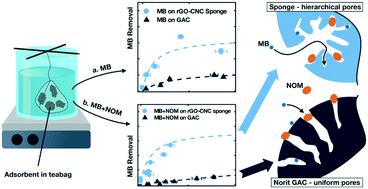当前位置:
X-MOL 学术
›
Environ. Sci.: Nano
›
论文详情
Our official English website, www.x-mol.net, welcomes your
feedback! (Note: you will need to create a separate account there.)
Graphene oxide sponge as adsorbent for organic contaminants: comparison with granular activated carbon and influence of water chemistry
Environmental Science: Nano ( IF 5.8 ) Pub Date : 2020-08-26 , DOI: 10.1039/d0en00193g Raphaela Allgayer 1, 2, 3, 4, 5 , Nariman Yousefi 1, 1, 2, 3, 4 , Nathalie Tufenkji 1, 2, 3, 4
Environmental Science: Nano ( IF 5.8 ) Pub Date : 2020-08-26 , DOI: 10.1039/d0en00193g Raphaela Allgayer 1, 2, 3, 4, 5 , Nariman Yousefi 1, 1, 2, 3, 4 , Nathalie Tufenkji 1, 2, 3, 4
Affiliation

|
There is growing interest in graphene oxide (GO) as an adsorbent for recalcitrant organic contaminants, such as industrial dyes and pharmaceutical compounds, because of its high specific surface area, amphiphilic character and versatile chemical functionality. GO nanosheets can be self-assembled into three-dimensional porous sponges to facilitate their removal from treated waters. Although a number of chemically and structurally diverse sponges have been fabricated for the removal of anthropogenic water pollutants, adsorption studies have mostly been limited to single contaminant solutions, omitting the environmentally relevant effect of organic co-contaminants and inorganic ions on the adsorption process. Furthermore, the adsorptive performance of the novel material is rarely compared to the industrial standard, granular activated carbon. In this work, we show that a reduced graphene oxide (rGO)–cellulose nanocrystal sponge has a high initial adsorption rate of 17.0 mg g−1 s−1 and the specific adsorption capacity for the model dye methylene blue is three times higher than that of a commonly used commercial granular activated carbon. With a novel HPLC method to quantify methylene blue in the presence of natural organic matter, we show that the adsorption of methylene blue on the sponge is not influenced by environmentally relevant concentrations of natural organic matter. However, organic co-contamination does inhibit the removal of the dye by granular activated carbon. Ionic strength and pH of the contaminant solution do not significantly impact the performance of the rGO sponge. Differences in adsorptive performance between the sponge and GAC are attributed to differences in the surface chemistry and pore structure of the adsorbents.
中文翻译:

氧化石墨烯海绵作为有机污染物的吸附剂:与颗粒状活性炭的比较和水化学的影响
由于氧化石墨烯(GO)具有高的比表面积,两亲性和通用的化学功能性,因此越来越受到人们的关注,因为氧化石墨烯(GO)作为难吸收的有机污染物(例如工业染料和药物化合物)的吸附剂。GO纳米片可以自组装成三维多孔海绵,以方便将其从处理后的水中去除。尽管已制造出许多化学和结构上不同的海绵来去除人为水污染物,但吸附研究主要限于单一污染物溶液,而忽略了有机共污染物和无机离子对吸附过程的环境影响。此外,与工业标准颗粒状活性炭相比,新型材料的吸附性能极少。-1 s -1和模型染料亚甲蓝的比吸附容量是常用的市售颗粒状活性炭的三倍。用一种新型的HPLC方法在存在天然有机物的情况下对亚甲基蓝进行定量,我们表明亚甲基蓝在海绵上的吸附不受环境相关浓度的天然有机物的影响。但是,有机共污染确实会抑制颗粒状活性炭去除染料。污染物溶液的离子强度和pH值不会显着影响rGO海绵的性能。海绵和GAC之间的吸附性能差异归因于吸附剂的表面化学和孔结构差异。
更新日期:2020-09-18
中文翻译:

氧化石墨烯海绵作为有机污染物的吸附剂:与颗粒状活性炭的比较和水化学的影响
由于氧化石墨烯(GO)具有高的比表面积,两亲性和通用的化学功能性,因此越来越受到人们的关注,因为氧化石墨烯(GO)作为难吸收的有机污染物(例如工业染料和药物化合物)的吸附剂。GO纳米片可以自组装成三维多孔海绵,以方便将其从处理后的水中去除。尽管已制造出许多化学和结构上不同的海绵来去除人为水污染物,但吸附研究主要限于单一污染物溶液,而忽略了有机共污染物和无机离子对吸附过程的环境影响。此外,与工业标准颗粒状活性炭相比,新型材料的吸附性能极少。-1 s -1和模型染料亚甲蓝的比吸附容量是常用的市售颗粒状活性炭的三倍。用一种新型的HPLC方法在存在天然有机物的情况下对亚甲基蓝进行定量,我们表明亚甲基蓝在海绵上的吸附不受环境相关浓度的天然有机物的影响。但是,有机共污染确实会抑制颗粒状活性炭去除染料。污染物溶液的离子强度和pH值不会显着影响rGO海绵的性能。海绵和GAC之间的吸附性能差异归因于吸附剂的表面化学和孔结构差异。











































 京公网安备 11010802027423号
京公网安备 11010802027423号